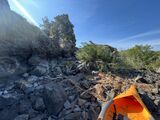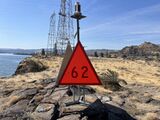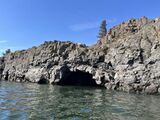Seaman Island
Seaman Island | |
|---|---|
Borough of Avon | |
| Borough of Seaman Island | |
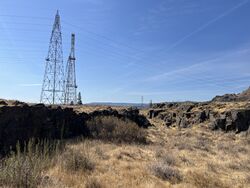 | |
| Country | |
| Established | 7 May 2022 |
| Founded by | Asher Young |
| Seat | Demain |
| Area | |
| • Total | 0.069 km2 (0.027 sq mi) |
| Population | |
| • Total | 1 |
Seaman Island is a borough of the State of Avon that was founded in May 2022. Seaman Island is geographically very close to the Shaniko and Wishram boroughs, in addition to the Faltrian city of Charbonneau. Seaman Island is, as the name suggests, an island, and is one of two islands in Avon (the other being Gansholm in the Commission des Ours). Seaman Island has a population of 1.
Etymology
The name of Seaman Island is taken from the name of Seaman, the Newfoundland dog of Merriweather Lewis, who led the 1804 Lewis and Clark Expedition that passed through the site of modern-day Avon. It is possible that the expedition party even camped on Seaman Island in October of 1805[1].
Vexillology
Seaman Island's flag includes many elements related to its etymology. The pink stripe on the bottom is inspired by the tricolor of the Newfoundland flag. The dog itself is a Newfoundland Labrador, poised in a position (in combination with a five-pointed star) that is reminiscent of the flag of the California Republic. '1804' marks the year that the Lewis and Clark Expedition began.
History
Seaman Island was claimed by the city of Nolius on 7 May 2022, alongside Shaniko and Wishram. Unlike those other claims, however, Seaman Island had not actually been physically visited, due to its status as an island. It was not until 2023 that the island would be visited by Avonites.
Seaman Island Expedition
In the morning of 10 September 2023, Asher Young visited the island via kayak. After disembarking from a small beach along the coast of Wishram, Young maneuvered downriver and up the eastern shore of the island before landing on its northern tip. Young scaled the basalt cliffs surrounding the landing site and navigated southward alongside the eastern part of the island, taking note of the geography and landmarks. Upon reaching the southernmost point of the island, Young turned around and made his way back to the landing site, navigating along the rocky western shore. At around noon, Young disembarked from Seaman Island and kayaked south through the channel separating the island from Shaniko, and landed again at the Leschi National Rivershore in Charbonneau, concluding the expedition. Young would enshrine 10 September as the Avonite national holiday of Island Day shortly thereafter.
-
Young's landing site on the northern end of the island.
-
Seaman Island's northern landscape.
-
A river mark along the cliffs.
-
A submerged cave inside of the eastern cliffside.
-
A peculiar rock formation on the southern part of the island.
Geography
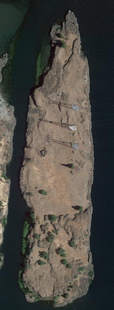
Geological features
Seaman Island, much like other areas along the Columbia River, is notable for its basalt deposits, that form in upward columns. These columnar basalt formations line the edge of the island, creating a dramatic cliff face on the eastern side of the island. The eastern side of the island is much higher in elevation than the western side, which is on average near or at sea level. A few interesting geological landmarks can be found on the island, such as lone basalt formations, submerged caves, patches of pumice, and lava tubes.
Flora
Most of the island is covered with dry, yellow grass. Though Shaniko is also covered with yellow grass, the grass on Seaman Island is much softer due to the lack of any frequent human presence. Both deciduous and evergreen pine trees are found on Seaman Island, though the distribution of trees is disproportionate, with significantly more found on the southern portion. Edible mullein plants and brambles are found on the southern and northern ends of the island respectively.
Fauna
Seaman Island is home to a host of small animal populations, including squirrels, chipmunks, and herons. There are transient presences of raptor birds such as bald eagles, various species of owl, and red-tailed hawks.
References
- ↑ columbiariverimages.com Retrieved 10 September, 2023

